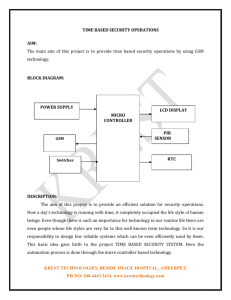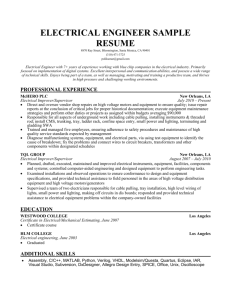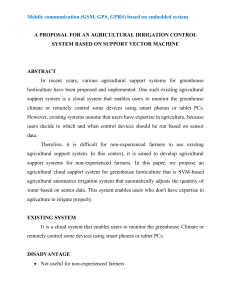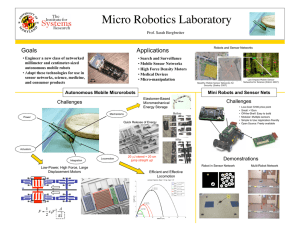www.ijecs.in International Journal Of Engineering And Computer Science ISSN: 2319-7242
advertisement
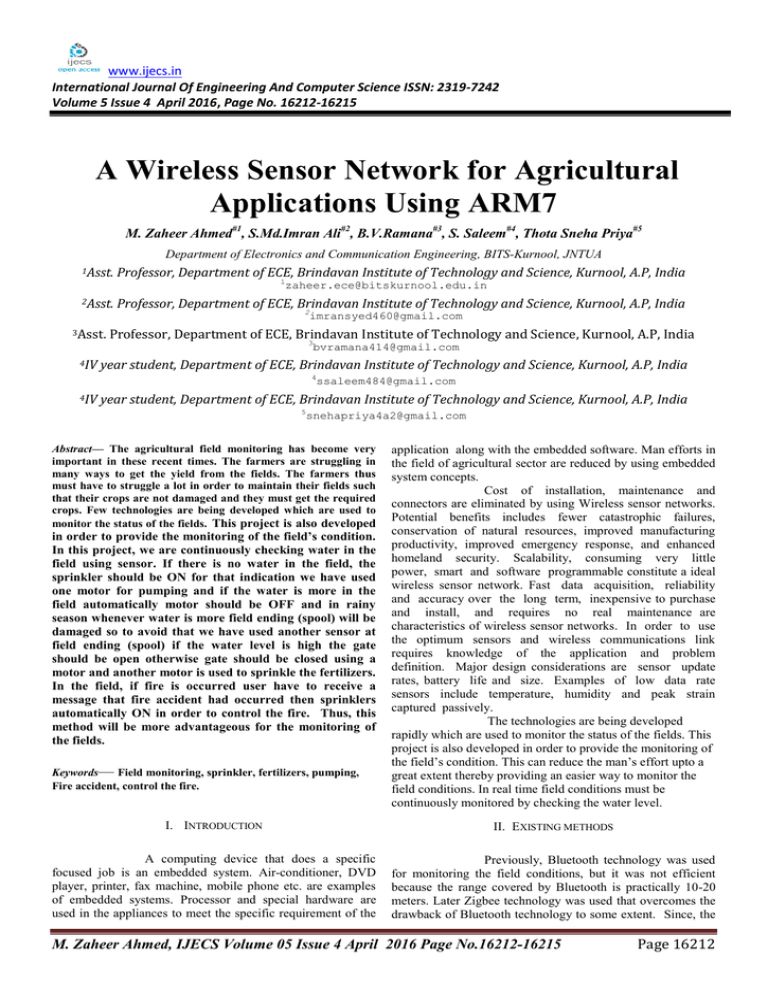
www.ijecs.in International Journal Of Engineering And Computer Science ISSN: 2319-7242 Volume 5 Issue 4 April 2016, Page No. 16212-16215 A Wireless Sensor Network for Agricultural Applications Using ARM7 M. Zaheer Ahmed#1, S.Md.Imran Ali#2, B.V.Ramana#3, S. Saleem#4, Thota Sneha Priya#5 Department of Electronics and Communication Engineering, BITS-Kurnool, JNTUA 1Asst. Professor, Department of ECE, Brindavan Institute of Technology and Science, Kurnool, A.P, India 1 zaheer.ece@bitskurnool.edu.in 2Asst. Professor, Department of ECE, Brindavan Institute of Technology and Science, Kurnool, A.P, India 2 imransyed460@gmail.com 3Asst. 4IV Professor, Department of ECE, Brindavan Institute of Technology and Science, Kurnool, A.P, India 3 bvramana414@gmail.com year student, Department of ECE, Brindavan Institute of Technology and Science, Kurnool, A.P, India 4 ssaleem484@gmail.com 4IV year student, Department of ECE, Brindavan Institute of Technology and Science, Kurnool, A.P, India 5 snehapriya4a2@gmail.com Abstract— The agricultural field monitoring has become very important in these recent times. The farmers are struggling in many ways to get the yield from the fields. The farmers thus must have to struggle a lot in order to maintain their fields such that their crops are not damaged and they must get the required crops. Few technologies are being developed which are used to monitor the status of the fields. This project is also developed in order to provide the monitoring of the field’s condition. In this project, we are continuously checking water in the field using sensor. If there is no water in the field, the sprinkler should be ON for that indication we have used one motor for pumping and if the water is more in the field automatically motor should be OFF and in rainy season whenever water is more field ending (spool) will be damaged so to avoid that we have used another sensor at field ending (spool) if the water level is high the gate should be open otherwise gate should be closed using a motor and another motor is used to sprinkle the fertilizers. In the field, if fire is occurred user have to receive a message that fire accident had occurred then sprinklers automatically ON in order to control the fire. Thus, this method will be more advantageous for the monitoring of the fields. Keywords— Field monitoring, sprinkler, fertilizers, pumping, Fire accident, control the fire. application along with the embedded software. Man efforts in the field of agricultural sector are reduced by using embedded system concepts. Cost of installation, maintenance and connectors are eliminated by using Wireless sensor networks. Potential benefits includes fewer catastrophic failures, conservation of natural resources, improved manufacturing productivity, improved emergency response, and enhanced homeland security. Scalability, consuming very little power, smart and software programmable constitute a ideal wireless sensor network. Fast data acquisition, reliability and accuracy over the long term, inexpensive to purchase and install, and requires no real maintenance are characteristics of wireless sensor networks. In order to use the optimum sensors and wireless communications link requires knowledge of the application and problem definition. Major design considerations are sensor update rates, battery life and size. Examples of low data rate sensors include temperature, humidity and peak strain captured passively. The technologies are being developed rapidly which are used to monitor the status of the fields. This project is also developed in order to provide the monitoring of the field‘s condition. This can reduce the man‘s effort upto a great extent thereby providing an easier way to monitor the field conditions. In real time field conditions must be continuously monitored by checking the water level. I. INTRODUCTION II. EXISTING METHODS A computing device that does a specific focused job is an embedded system. Air-conditioner, DVD player, printer, fax machine, mobile phone etc. are examples of embedded systems. Processor and special hardware are used in the appliances to meet the specific requirement of the Previously, Bluetooth technology was used for monitoring the field conditions, but it was not efficient because the range covered by Bluetooth is practically 10-20 meters. Later Zigbee technology was used that overcomes the drawback of Bluetooth technology to some extent. Since, the M. Zaheer Ahmed, IJECS Volume 05 Issue 4 April 2016 Page No.16212-16215 Page 16212 DOI: 10.18535/Ijecs/v5i4.27 Zigbee technology that was used only for certain distance, this implementation became failure because of so many disadvantages. One of the main disadvantage is the range of Zigbee is approximately 100 meters. Also the user has to send the commands for its functioning. Sending the command for its proper functioning is tedious and also increases human effort. As the Zigbee‘s range is smaller, the farmer should be nearer to operate the equipment and know the information regarding the field‘s status. But as the person will nearer to the field, he can manually monitor all the field conditions. III. PROPOSED METHOD Block Diagram: POWER SUPPLY WATER LEVEL INDICATOR L P C 2 1 4 8 MOTOR FOR WATER SPRINKLING L293D MOTOR FOR PESTICIDE SPRINKLING MAX 232 SMOKE SENSOR GSM MODEM Fig.1 Block Diagram of Agriculture Monitoring System Working: In order to monitor the conditions in the field the user should register his mobile number, the registered mobile number will displayed on the lcd and user will get an reply message as modem is initialized, Automatically the motors in the field will start working, one motor is for sprinkling of water and another motor is to sprinkle pesticides, if the field become wet the water level indicator will indicate the water level and user get an message as level-1 motor is full, Automatically the motor will be off. In case of any fire accidents occurred in the field, the smoke sensor will detect the smoke and the motors will start sprinkling water so that the fire will be controlled. The power supply given to the microcontroller is 230V AC but the microcontroller uses the power 3.4v only. For indicating the water level the npn transistor is used, the emitter terminal is placed at one end of the field and the collector terminal is placed at another end of the field, when the field becomes wet the both terminals will get short circuited and automatically the motors will stop sprinkling water. The motors are not directly connected with the microcontroller, the motors are connected to L293D driver and that diver is connected to microcontroller, the purpose of using this driver is the voltage coming from microcontroller is only 3.4v but it is not sufficient to work the motors , it requires 12v , the L293D driver will produce the sufficient voltage. If any fire accidents will occur in the field the smoke sensor will detect the smoke and the motors will sprinkle water automatically, here the smoke sensor used is MQ-3. Hardware Component Description A) Microcontroller: The LPC2148 microcontrollers are based on a 16-bit/32-bit ARM7TDMI-S CPU with real-time emulation and embedded trace support, that combine microcontroller with embedded high speed flash memory ranging from 32 KB to 512 KB. Regulated power supply is used to apply the input to circuit. 230V input is step down to 12V by the transformer and is fed to a rectifier from the mains supply. Pulsating dc voltage is obtained from rectifier. The output voltage from the rectifier is fed to a filter to get pure dc voltage and any ac components present even after rectification is removed. To obtain a pure constant dc voltage, voltage regulator is fed with this voltage. Quadruple high-current half-H drivers are L293D . Bidirectional drive currents of up to 1 A at voltages from 4.5 V to 36 V is provided by L293. Bidirectional drive currents of up to 600mA at voltages from 4.5 V to 36 V is obtained by using L293D design. Iductive loads such as relays, solenoids, dc and bipolar stepping motors, as well as other highcurrent/high-voltage loads in positive-supply application are driven by both designs. M. Zaheer Ahmed, IJECS Volume 05 Issue 4 April 2016 Page No.16212-16215 Page 16213 DOI: 10.18535/Ijecs/v5i4.27 B) Motors: Electric motors are used to efficiently convert electrical energy into mechanical energy. Basic principle of operation is magnetism. Permanent magnets, electromagnets are used and amazing machines are created by exploiting the magnetic properties of materials. C) LCD: LCD stands for Liquid Crystal Display. LCD is finding wide spread use replacing LEDs (seven segment LEDs or other multi segment LEDs). The LCD will be having 16-pins. It had 8 data pins, which are D0-D7. It can be used as a 8-bit or as a 4- bit. D) GSM: For transmitting mobile voice and data services the open, digital cellular technology used is Global System for Mobile communications . Widely used digital mobile telephone system in Europe and other parts of the world is Global System for Mobile communication. Among three digital wireless telephone technologies (TDMA, GSM, and CDMA) GSM uses a variation of Time Division Multiple Access. Digitizing and compressing the data , then sending it down a channel with two other streams of user data, each in its own time slot is done through GSM. 900 MHz or 1,800 MHz frequency band are used in global system for mobile communication. Voice calls and data transfer speeds of up to 9.6 kbit/s, together with the transmission of SMS (Short Message Service) are supported by GSM. E) Power supply: A 5V, 500mA power supply is used. Unregulated 12V DC is used for relay. For voltage regulation 3 terminal device 7805 is used. Full wave bridge rectifier is used to rectify the ac output of secondary of 230/12V step down transformer. The required voltage is 3.4V. IV. RESULTS Fig.1 Name of the project displayed on the LCD screen after the kit is switched on Fig.3 The mobile number which. is registered is displayed Fig.2 Indication for asking the registration of the mobile number Fig.4 The conditions of the field being displayed on the LCD Screen M. Zaheer Ahmed, IJECS Volume 05 Issue 4 April 2016 Page No.16212-16215 Page 16214 DOI: 10.18535/Ijecs/v5i4.27 implemented in order to reduce man‘s effort in the field monitoring. This project has been verified and thus it is more advantageous than the other methods. Hence this project can provide more benefits for the farmers and also modernises the agricultural methods. In future an advanced movable robot is developed that will be monitoring the field conditions , without human intervention. REFERENCES [1] Fig.5 Field conditions which are transmitted through GSM V. CONCLUSION & FUTURE SCOPE Here an efficient agricultural monitoring system is developed using wireless sensor networks and the coverage range is also increased by the use of GSM technology which inturns uses Time division multiple access scheme. The implemented systems continuously monitors the field conditions and automatically solves the problems that arises in the field such as water deficiency , fire, excess water and deficiency of the pesticides and also informs the status of the field to the user time to time regularly. This project is thus [2] [3] [4] [5] [6] [7] Mahesh M. Galgalikar ‗Real-Time Automization Of Agricultural Environment for Social Modernization of Indian Agricultural System‘ IEEE 978-1-4244-5586-7/10/$26.00 C 2010 Real-time automation of agricultural environment for modernization of Indian agricultural system. 2010 International Journal of Computer Applications (0975 - 8887) Volume 1 – No. 22. Irrigation Security of Reclaimed Water Based on Water Quality in Beijing by Luxuan Yang and Jinfeng Deng,2010 IEEE. David E. Simon, An Embedded Software Primer, fifth edition, 2007. F.H. Tani, S. Barrington. ―Zinc and copper uptake by plants under two transpiration rates.Part I. Wheat (Triticum aestivum L.),‖ Environmental Pollution, 138. pp. 538-547, 2005. Mahesh M. Galgalikar ‗Real-Time Automization Of Agricultural Environment for Social Modernization of Indian Agricultural System‘ IEEE 978-1-4244-5586-7/10/$26.00 C 2010 K. Nirmal Kumar P.Ranjith R.Prabakaran ‗Real Time Paddy Crop Field Monitoring Using Zigbee Network‘, IEEE 978-1-4244-79269/11/$26.00 [8] M. Zaheer Ahmed, IJECS Volume 05 Issue 4 April 2016 Page No.16212-16215 Page 16215

